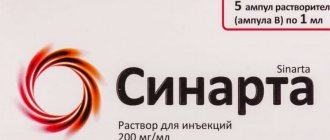Urografin injection solution 76% 20ml amp 10 pcs
For all indications. The following precautions should be observed for all routes of administration, but the risk of adverse events is greater with intravenous administration.
Hypersensitivity.
In some cases, after the introduction of radiocontrast agents, such as the drug
Urografin®, allergic-like hypersensitivity reactions may occur.
These reactions usually manifest as mild respiratory and skin symptoms: difficulty breathing, redness of the skin (erythema), hives, itching or swelling of the face.
Severe reactions are possible: vascular edema, swelling of the larynx below the folds of the glottis, bronchospasm and allergic shock. Typically, these reactions occur within one hour after administration of the radiocontrast agent; in rare cases, delayed reactions may occur (after several hours to days).
Patients with hypersensitivity or those who have previously had reactions to iodinated contrast agents are at increased risk of developing severe reactions.
The incidence of adverse reactions is higher in patients with a history of allergies (eg, seafood allergy, hay fever, urticaria), sensitivity to iodine or radiocontrast agents, and bronchial asthma. In this regard, before the administration of a radiocontrast agent, the patient should be questioned about any history of allergies. In such cases, the need for prophylactic use of antihistamines and/or glucocorticosteroids should be considered.
Patients with bronchial asthma have an increased risk of developing bronchospasm or hypersensitivity reactions.
Hypersensitivity reactions may be increased in patients taking beta-blockers, especially in the presence of bronchial asthma. Moreover, it must be taken into account that patients taking beta-blockers may be resistant to standard therapy for hypersensitivity reactions with beta-agonists.
If a hypersensitivity reaction develops, the administration of the radiocontrast agent should be stopped immediately and, if necessary, special treatment should be started through the intravenous administration of appropriate drugs. In this case, it is advisable to use an intravenous catheter, which was intended for intravenous administration of radiocontrast agents. For emergency treatment, medications for resuscitation, an endotracheal tube and an artificial respiration apparatus must be ready.
Thyroid gland dysfunction.
The small amount of inorganic iodine present in iodinated contrast media solution may affect thyroid function. Therefore, the need for X-ray contrast studies should be especially carefully assessed in patients with latent hyperthyroidism or goiter.
Cardiovascular diseases.
There is an increased risk of severe reactions in patients with severe heart disease, especially those with heart failure and coronary artery disease.
Elderly age.
In elderly people, pathological changes in blood vessels and neurological disorders often occur, which increases the risk of developing adverse reactions to iodine-containing radiocontrast agents.
General serious condition.
The need for X-ray examination with contrast should be weighed especially carefully in patients with a general serious condition.
Intravascular administration.
Kidney failure.
In rare cases, kidney failure may occur. The following preventive measures should be taken to prevent acute renal failure during the administration of radiocontrast media:
Identify patients with risk factors, such as history of kidney disease, existing renal failure, history of renal failure after radiocontrast administration, diabetes mellitus with nephropathy, multiple myeloma, age over 60 years, progressive vascular disease, paraproteinemia, severe hypertension , gout, administration of large or repeated doses of the drug.
Patients at increased risk should be adequately hydrated prior to administration of radiocontrast media, preferably by intravascular infusion before and after the examination. The infusion should be continued until the radiocontrast agent is completely eliminated by the kidneys.
Until the radiocontrast agent is completely removed, additional stress on the kidneys in the form of nephrotoxic drugs, administration of cholecystographic oral drugs, arterial clamping, angioplasty of the renal arteries, or major surgery should be avoided.
Postpone a new X-ray contrast study until renal function is fully restored.
In patients on dialysis, X-rays can be performed using a radiocontrast agent, since iodinated contrast agents are eliminated from the body by dialysis.
Treatment with metformin.
The use of an intravascular radiocontrast agent excreted by the kidneys may lead to transient impairment of renal function. As a result, lactic acidosis may occur in patients taking biguanides (as a precaution, biguanides should be discontinued 48 hours before the contrast study and should not be taken for at least 48 hours afterward).
Cardiovascular diseases.
In patients with valvular heart disease and pulmonary hypertension, administration of a radiocontrast agent can lead to significant hemodynamic changes. Elderly patients and patients with a history of heart disease are more likely to experience ischemic ECG changes and arrhythmias.
In patients with heart failure, intravascular administration of radiocontrast media may cause pulmonary edema.
CNS disorders.
Particular care should be taken when intravascularly administering a radiocontrast agent to patients with acute cerebral infarction, acute intracranial hemorrhage and other diseases accompanied by disruption of the integrity of the blood-brain barrier, cerebral edema or acute demyelination. The incidence of seizures after administration of iodinated contrast media is higher in patients with intracranial tumors or metastases and a history of epilepsy. The introduction of a radiocontrast agent can contribute to the appearance of neurological symptoms in diseases of the cerebral vessels, the presence of intracranial tumors or metastases, degenerative or inflammatory diseases of the central nervous system. Intra-arterial administration of a radiocontrast agent can lead to vasospasm and subsequent cerebral ischemia. The risk of neurological complications is higher in patients with symptoms of cerebrovascular disease, recent stroke, or frequent transient ischemic attacks.
Severe liver dysfunction
In cases of severe renal failure, concomitant severe liver dysfunction may markedly slow down the excretion of radiocontrast media and lead to the need for hemodialysis.
Myeloma and paraproteinemia.
Multiple myeloma or paraproteinemia may contribute to renal dysfunction when radiocontrast is administered. In this case, adequate hydration is mandatory.
Pheochromocytoma.
In patients with pheochromocytoma, due to the risk of developing a vascular crisis, preliminary administration of alpha-blockers is recommended.
Patients with autoimmune diseases.
Patients with autoimmune disorders may experience cases of severe vasculitis or a syndrome similar to Stevens-Johnson syndrome.
Myasthenia gravis.
The administration of iodinated contrast media may increase the symptoms of myasthenia gravis.
Alcoholism.
Acute or chronic alcoholism can increase the permeability of the blood-brain barrier. This facilitates the penetration of the radiocontrast agent into the brain tissue and can lead to reactions from the central nervous system. Particular caution should be exercised in patients with alcoholism and people taking drugs, due to a possible decrease in the seizure threshold.
Blood coagulation system.
Ionic iodine-containing X-ray contrast agents, compared to non-ionic X-ray contrast agents, inhibit the blood coagulation system more strongly in vitro. However, when catheterizing a vessel and performing angiography, medical personnel should frequently flush the catheter with saline (with the addition of heparin if possible) and reduce the duration of the study as much as possible to minimize the risk of thrombosis and embolism.
The use of plastic syringes instead of glass has been reported to reduce, but not completely eliminate, in vitro blood clotting.
Caution should be exercised in patients with homocystinuria, as they have a risk of thrombosis and embolism.
Introduction into body cavities.
Before performing hysterosalpingography, possible pregnancy should be excluded.
The risk of adverse reactions during cholangiography, ERCP or hysterosalpingography increases in the presence of inflammation of the bile ducts or fallopian tubes.
INFLUENCE ON THE ABILITY TO DRIVE VEHICLES AND MECHANISMS.
No studies have been conducted on the effect on the ability to drive vehicles or operate machinery. It is not recommended to drive vehicles or engage in other potentially hazardous activities that require increased concentration and speed of psychomotor reactions for 24 hours after the study.
Urografin
Excretory urography: 20-40 ml of a 60% solution of the drug, warmed to body temperature, is slowly injected into the cubital vein; for unprepared (without a cleansing enema) or obese patients, it is better to use a 76% solution in the same amount; in case of reduced kidney function, administer intravenously by drip, diluted in 250-300 ml of 5% dextrose, for 5-10 minutes. Children - 60% solution: infants - 7-9 ml, children 1-6 years old - 9-12 ml, 6-12 years old - 12-15 ml, 12-15 years old - 15-20 ml; if the drug cannot be administered intravenously, then it is administered intramuscularly - the appropriate dose is diluted 2 times with water for injection and injected in 2 places, half of the diluted solution deep into the muscle. Ascending pyelography: 5-10 ml of a 30% solution is slowly injected using a catheter; If the slightest pain or pressure appears in the kidney area, the administration is stopped. Phlebography: for the lower extremities - 20-40 ml, for the upper extremities - 10-20 ml of a 60% solution; pictures are taken already during the administration of the drug; After the examination, it is necessary to ensure that the contrast drug is removed from the limbs: the limb is raised and the vein is washed with 50-70 ml of 0.9% NaCl solution. Peripheral arteriography: 20 ml is used for the lower extremities, and 10-20 ml of a 60% solution is used for the upper extremities; For better tolerability, administration in the direction against the blood flow is recommended. Cerebral angiography: on average, 7 ml of a 60% solution is injected into the carotid artery or 4 ml is injected into the vertebral artery; with simultaneous seriography in 2 planes, 1 injection is sufficient, otherwise for the second projection the injection must be repeated; the solution is injected quickly (10 ml in approximately 1.5 s). Aortography: 30-50 ml of 76% solution intra-aortically at maximum speed. Digital (digital) arteriography: 60% solution in an amount corresponding to the size of the bloodstream of the artery being examined. Angiocardiography: up to 60 ml of 76% solution at maximum speed, for children - up to 1.2 ml/kg. Splenoportography: 20-30 ml of 76% solution. Cholangiography: 5-20 ml of 35% solution. Cystography: on average 60-80 ml of a 35% solution of the drug into the external opening of the urethra or 20 ml when a catheter is inserted into the bladder along with air (lacunar cystography). Arthrography: a 35% solution, warmed to body temperature, is slowly injected in the required amount after routine disinfection of the joint; contrast drug is administered after removal of exudate under aseptic conditions; the solution is administered with the patient in a “lying” position; To dilute the solution, use only water for injection.



